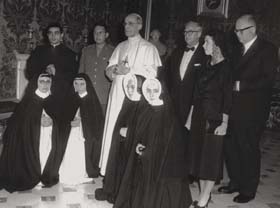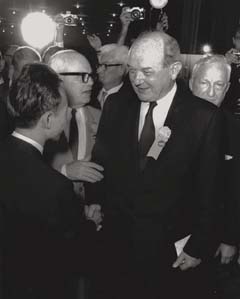- World
- Contemporary
- History
Jay Lovestone was one of the half-dozen most powerful men in the hidden American power structure during the Cold War period. Not a household name, Lovestone deliberately avoided interviews, shunning television and other public appearances. For thirty years, from 1944 to 1974, as head of the AFL-CIO Free Trade Committee, he operated an international network to promote independent labor organizations in Europe, India, Japan, Africa, and the Arab world. During the crucial postwar years, he was in a sense George Meany’s foreign minister. He anticipated the problem of Soviet penetration of European labor unions and set up an organization to prevent communist influence from spreading at the end of the war. For twenty years, from 1954 to 1974, Lovestone and James Angleton of the CIA worked closely together. As a cold warrior, Lovestone was equally opposed to communism, colonialism, and plutocracy.
 The Jay Lovestone papers in the Hoover Archives contain dozens of photo-graphs of the Zelig-like Lovestone posing with world leaders. In this photo, Lovestone, in bowtie, meets with Pope Pius XII (1955). The Jay Lovestone papers in the Hoover Archives contain dozens of photo-graphs of the Zelig-like Lovestone posing with world leaders. In this photo, Lovestone, in bowtie, meets with Pope Pius XII (1955).Courtesy of the Hoover Institution Archives. |
The Hoover Institution Archives acquired Jay Lovestone’s extensive collection of papers in 1975. The Lovestone papers, in more than seven hundred boxes, chronicle his career in great detail, revealing the work that he conducted under at least twenty different pseudonyms. Given the clandestine nature of much of his work, it is not surprising that Lovestone stipulated that his collection be closed for research until five years after his death, which occurred in 1990.When the Lovestone files were finally opened in 1995, the Pulitzer Prize–winning writer Ted Morgan was the first in line to look at them. Morgan is well known for his remarkable and highly readable biographies of Winston Churchill, Franklin D. Roosevelt, and W. Somerset Maugham. Morgan selected Lovestone as his new subject because of the man’s complexity and his hidden role in the international arena.
 Lovestone peers out from behind the shoulder of former secretary of state Dean Rusk (1971). Lovestone peers out from behind the shoulder of former secretary of state Dean Rusk (1971).Courtesy of the Hoover Institution Archives. |
Morgan joked that looking through the Lovestone photographs reminded him of the Woody Allen movie Zelig, in which a complete unknown is seen in the company of history’s great leaders. In photographs in the Hoover Archives Lovestone’s unfamiliar face is shown with those of the movers and shakers of the postwar world: Lovestone with the pope, with Nixon, Meany, Adenauer, and Willi Brandt; Lovestone as the gray eminence behind Dean Rusk’s shoulder. Lovestone met with Franklin Roosevelt, gave advice to both Lyndon Johnson and Richard Nixon. Much of his counsel was devoted to warning Americans about the totalitarian methods of the communist bloc.
Jay Lovestone’s opposition to the communist movement evolved from his firsthand experiences in the American Communist Party underground. In 1917 Lovestone was a student activist at City College in New York. He was contentious by nature, and his political combativeness was aroused by the events of World War I and the Russian Revolution. He shifted quickly from the left wing of the socialist movement to the new Russian-inspired communist movement.
In 1919, a young man of twenty-one, he served as one of the founders of the American Communist Party. Lovestone was a leading figure in the party for ten years. He worked so closely with party leader Charles Ruthenberg that Lovestone, a bachelor, frequently referred to Ruthenberg as his “wife.” (Ted Morgan deciphered this whimsical code word, along with many aliases in the papers, with the help of Lovestone’s old friends. Grace Hawes, the archival specialist who processed the Lovestone papers, was able to supply Morgan with additional pseudonyms.) Lovestone poured his considerable energy into the factional fighting that characterized the CPUSA, fights that were often resolved by taking the disputes to Moscow to be adjudicated. After Ruthenberg’s death in 1927, Lovestone served as CPUSA general secretary until 1929. This leadership position came to an abrupt end when Lovestone, on a trip to Moscow, challenged Stalin’s authority. Lovestone was lucky to get out of the Soviet Union alive; once home he found himself expelled from the party he thought he was leading.
For the next ten years Lovestone tried to retain his Marxist faith as the leader of a communist party that opposed the Soviet-controlled CPUSA. Although he wanted to recover his old influence and tried to win back the support of the Russians, the Lovestoneite group never numbered more than a couple of hundred members. Newly released documents from the Comintern files in Moscow show that Lovestone was still doing intelligence chores for the Soviet Union as late as 1936, some seven years after his expulsion from the CPUSA.
The papers chronicle Lovestone’s career in great detail, revealing work he conducted under at least twenty different pseudonyms.
The complications of such a life are difficult to untangle. Lovestone maintained at least four different names, identities, and bank accounts. Some of his statements from this period are wildly imaginative. He sometimes told people he was born on a farm in upstate New York, when he in fact was born in tsarist Lithuania.
By 1941, his disillusionment with communism complete, Lovestone dismantled his opposition communist group. For the remainder of his life Lovestone preached that only a former communist could truly appreciate the dangers that this ideology posed for the world.
In the 1940s Lovestone became affiliated with the ILGWU (the International Ladies Garment Workers Union) and took a leadership position in the American Federation of Labor. Suddenly able to influence tens of thousands of workers, he achieved the prominence that had eluded him when he was head of the tiny Lovestoneite faction. He used union funds to expand the international ties of the AFL and later of the combined AFL-CIO. His work attracted the admiration of the CIA, which began contributing funding in the 1950s. He used a network of labor attachés at U.S. embassies abroad to spread the concept of independent labor unions. Even as the power of the labor movement faded in the United States, the influence of the AFL-CIO abroad was strongly felt. The Polish Solidarity trade union is an outgrowth of this international political movement.
Lovestone made good use of his CIA connections, but he never completely submitted to the discipline of the CIA or the AFL-CIO any more than he had to that of Stalin. For all of the remarkable turnabouts in his long career, the consistent theme in his life was an almost visceral need for freedom.
Herbert Hoover himself persuaded Lovestone that the Hoover Institution Archives would be the best place for his papers. Also, Hoover Institution research fellow Arnold Beichman knew the Lovestone circle well and had a lively correspondence with Lovestone, which he recently donated to the archives. In addition, one of Lovestone’s operatives, Louise Page Morris, has generously donated her correspondence to the archives, meaning that the body of material on this fascinating man continues to grow.







